功能背景
由于线程池的参数配置是一个比较难准确配置好, 如果需要进行配置修改, 就会对配置进行修改,再进行部署,影响效率, 或者应用场景的变化,导致固定的配置很难满足当前需求, 需要对线程池的参数进行动态配置, 查找资料发现很多博客在说美团发布的一篇文字《Java线程池实现原理及其在美团业务中的实践》, 于是手进行实现
ThreadPoolExecutor配置
mport io.micrometer.core.instrument.util.NamedThreadFactory;
import org.springframework.context.annotation.Bean;
import org.springframework.context.annotation.Configuration;
import java.util.concurrent.ThreadPoolExecutor;
import java.util.concurrent.TimeUnit;
/**
* desc: 线程池配置
*
* @author qts
* @date 2023/11/15 0015
*/
@Configuration
public class ThreadPoolConfig {
@Bean
public ThreadPoolExecutor threadPoolExecutor() {
return new ThreadPoolExecutor(2,
4,
60, TimeUnit.SECONDS,
new ResizableCapacityLinkedBlockingQueue<>(10),
new NamedThreadFactory("my-executor"),
new ThreadPoolExecutor.CallerRunsPolicy());//拒绝策略:当前调用线程进行执行
}
}
自定义可变容LinkedBlockingQueue
由于LinkedBlockingQueue中的capacity被 final修饰,无法进行修改, 故将LinkedBlockingQueue代码复制,后将capacity的final删除,并提getter和setter方法, 代码如下
/*
* ORACLE PROPRIETARY/CONFIDENTIAL. Use is subject to license terms.
*/
/*
* Written by Doug Lea with assistance from members of JCP JSR-166
* Expert Group and released to the public domain, as explained at
* http://creativecommons.org/publicdomain/zero/1.0/
*/
import java.util.*;
import java.util.concurrent.BlockingQueue;
import java.util.concurrent.TimeUnit;
import java.util.concurrent.atomic.AtomicInteger;
import java.util.concurrent.locks.Condition;
import java.util.concurrent.locks.ReentrantLock;
import java.util.function.Consumer;
/**
* An optionally-bounded {@linkplain BlockingQueue blocking queue} based on
* linked nodes.
* This queue orders elements FIFO (first-in-first-out).
* The <em>head</em> of the queue is that element that has been on the
* queue the longest time.
* The <em>tail</em> of the queue is that element that has been on the
* queue the shortest time. New elements
* are inserted at the tail of the queue, and the queue retrieval
* operations obtain elements at the head of the queue.
* Linked queues typically have higher throughput than array-based queues but
* less predictable performance in most concurrent applications.
*
* <p>The optional capacity bound constructor argument serves as a
* way to prevent excessive queue expansion. The capacity, if unspecified,
* is equal to {@link Integer#MAX_VALUE}. Linked nodes are
* dynamically created upon each insertion unless this would bring the
* queue above capacity.
*
* <p>This class and its iterator implement all of the
* <em>optional</em> methods of the {@link Collection} and {@link
* Iterator} interfaces.
*
* <p>This class is a member of the
* <a href="{@docRoot}/../technotes/guides/collections/index.html">
* Java Collections Framework</a>.
*
* @since 1.5
* @author Doug Lea
* @param <E> the type of elements held in this collection
*/
public class ResizableCapacityLinkedBlockingQueue<E> extends AbstractQueue<E>
implements BlockingQueue<E>, java.io.Serializable {
private static final long serialVersionUID = -6903933977591709194L;
/*
* A variant of the "two lock queue" algorithm. The putLock gates
* entry to put (and offer), and has an associated condition for
* waiting puts. Similarly for the takeLock. The "count" field
* that they both rely on is maintained as an atomic to avoid
* needing to get both locks in most cases. Also, to minimize need
* for puts to get takeLock and vice-versa, cascading notifies are
* used. When a put notices that it has enabled at least one take,
* it signals taker. That taker in turn signals others if more
* items have been entered since the signal. And symmetrically for
* takes signalling puts. Operations such as remove(Object) and
* iterators acquire both locks.
*
* Visibility between writers and readers is provided as follows:
*
* Whenever an element is enqueued, the putLock is acquired and
* count updated. A subsequent reader guarantees visibility to the
* enqueued Node by either acquiring the putLock (via fullyLock)
* or by acquiring the takeLock, and then reading n = count.get();
* this gives visibility to the first n items.
*
* To implement weakly consistent iterators, it appears we need to
* keep all Nodes GC-reachable from a predecessor dequeued Node.
* That would cause two problems:
* - allow a rogue Iterator to cause unbounded memory retention
* - cause cross-generational linking of old Nodes to new Nodes if
* a Node was tenured while live, which generational GCs have a
* hard time dealing with, causing repeated major collections.
* However, only non-deleted Nodes need to be reachable from
* dequeued Nodes, and reachability does not necessarily have to
* be of the kind understood by the GC. We use the trick of
* linking a Node that has just been dequeued to itself. Such a
* self-link implicitly means to advance to head.next.
*/
/**
* Linked list node class
*/
static class Node<E> {
E item;
/**
* One of:
* - the real successor Node
* - this Node, meaning the successor is head.next
* - null, meaning there is no successor (this is the last node)
*/
ResizableCapacityLinkedBlockingQueue.Node<E> next;
Node(E x) { item = x; }
}
/** The capacity bound, or Integer.MAX_VALUE if none */
private int capacity;
/** Current number of elements */
private final AtomicInteger count = new AtomicInteger();
/**
* Head of linked list.
* Invariant: head.item == null
*/
transient ResizableCapacityLinkedBlockingQueue.Node<E> head;
/**
* Tail of linked list.
* Invariant: last.next == null
*/
private transient ResizableCapacityLinkedBlockingQueue.Node<E> last;
/** Lock held by take, poll, etc */
private final ReentrantLock takeLock = new ReentrantLock();
/** Wait queue for waiting takes */
private final Condition notEmpty = takeLock.newCondition();
/** Lock held by put, offer, etc */
private final ReentrantLock putLock = new ReentrantLock();
/** Wait queue for waiting puts */
private final Condition notFull = putLock.newCondition();
/**
* Signals a waiting take. Called only from put/offer (which do not
* otherwise ordinarily lock takeLock.)
*/
private void signalNotEmpty() {
final ReentrantLock takeLock = this.takeLock;
takeLock.lock();
try {
notEmpty.signal();
} finally {
takeLock.unlock();
}
}
/**
* Signals a waiting put. Called only from take/poll.
*/
private void signalNotFull() {
final ReentrantLock putLock = this.putLock;
putLock.lock();
try {
notFull.signal();
} finally {
putLock.unlock();
}
}
/**
* Links node at end of queue.
*
* @param node the node
*/
private void enqueue(ResizableCapacityLinkedBlockingQueue.Node<E> node) {
// assert putLock.isHeldByCurrentThread();
// assert last.next == null;
last = last.next = node;
}
/**
* Removes a node from head of queue.
*
* @return the node
*/
private E dequeue() {
// assert takeLock.isHeldByCurrentThread();
// assert head.item == null;
ResizableCapacityLinkedBlockingQueue.Node<E> h = head;
ResizableCapacityLinkedBlockingQueue.Node<E> first = h.next;
h.next = h; // help GC
head = first;
E x = first.item;
first.item = null;
return x;
}
/**
* Locks to prevent both puts and takes.
*/
void fullyLock() {
putLock.lock();
takeLock.lock();
}
/**
* Unlocks to allow both puts and takes.
*/
void fullyUnlock() {
takeLock.unlock();
putLock.unlock();
}
// /**
// * Tells whether both locks are held by current thread.
// */
// boolean isFullyLocked() {
// return (putLock.isHeldByCurrentThread() &&
// takeLock.isHeldByCurrentThread());
// }
/**
* Creates a {@code ResizableCapacityLinkedBlockingQueue} with a capacity of
* {@link Integer#MAX_VALUE}.
*/
public ResizableCapacityLinkedBlockingQueue() {
this(Integer.MAX_VALUE);
}
/**
* Creates a {@code ResizableCapacityLinkedBlockingQueue} with the given (fixed) capacity.
*
* @param capacity the capacity of this queue
* @throws IllegalArgumentException if {@code capacity} is not greater
* than zero
*/
public ResizableCapacityLinkedBlockingQueue(int capacity) {
if (capacity <= 0) throw new IllegalArgumentException();
this.capacity = capacity;
last = head = new ResizableCapacityLinkedBlockingQueue.Node<E>(null);
}
/**
* Creates a {@code ResizableCapacityLinkedBlockingQueue} with a capacity of
* {@link Integer#MAX_VALUE}, initially containing the elements of the
* given collection,
* added in traversal order of the collection's iterator.
*
* @param c the collection of elements to initially contain
* @throws NullPointerException if the specified collection or any
* of its elements are null
*/
public ResizableCapacityLinkedBlockingQueue(Collection<? extends E> c) {
this(Integer.MAX_VALUE);
final ReentrantLock putLock = this.putLock;
putLock.lock(); // Never contended, but necessary for visibility
try {
int n = 0;
for (E e : c) {
if (e == null)
throw new NullPointerException();
if (n == capacity)
throw new IllegalStateException("Queue full");
enqueue(new ResizableCapacityLinkedBlockingQueue.Node<E>(e));
++n;
}
count.set(n);
} finally {
putLock.unlock();
}
}
// this doc comment is overridden to remove the reference to collections
// greater in size than Integer.MAX_VALUE
/**
* Returns the number of elements in this queue.
*
* @return the number of elements in this queue
*/
public int size() {
return count.get();
}
// this doc comment is a modified copy of the inherited doc comment,
// without the reference to unlimited queues.
/**
* Returns the number of additional elements that this queue can ideally
* (in the absence of memory or resource constraints) accept without
* blocking. This is always equal to the initial capacity of this queue
* less the current {@code size} of this queue.
*
* <p>Note that you <em>cannot</em> always tell if an attempt to insert
* an element will succeed by inspecting {@code remainingCapacity}
* because it may be the case that another thread is about to
* insert or remove an element.
*/
public int remainingCapacity() {
return capacity - count.get();
}
/**
* Inserts the specified element at the tail of this queue, waiting if
* necessary for space to become available.
*
* @throws InterruptedException {@inheritDoc}
* @throws NullPointerException {@inheritDoc}
*/
public void put(E e) throws InterruptedException {
if (e == null) throw new NullPointerException();
// Note: convention in all put/take/etc is to preset local var
// holding count negative to indicate failure unless set.
int c = -1;
ResizableCapacityLinkedBlockingQueue.Node<E> node = new ResizableCapacityLinkedBlockingQueue.Node<E>(e);
final ReentrantLock putLock = this.putLock;
final AtomicInteger count = this.count;
putLock.lockInterruptibly();
try {
/*
* Note that count is used in wait guard even though it is
* not protected by lock. This works because count can
* only decrease at this point (all other puts are shut
* out by lock), and we (or some other waiting put) are
* signalled if it ever changes from capacity. Similarly
* for all other uses of count in other wait guards.
*/
while (count.get() == capacity) {
notFull.await();
}
enqueue(node);
c = count.getAndIncrement();
if (c + 1 < capacity)
notFull.signal();
} finally {
putLock.unlock();
}
if (c == 0)
signalNotEmpty();
}
/**
* Inserts the specified element at the tail of this queue, waiting if
* necessary up to the specified wait time for space to become available.
*
* @return {@code true} if successful, or {@code false} if
* the specified waiting time elapses before space is available
* @throws InterruptedException {@inheritDoc}
* @throws NullPointerException {@inheritDoc}
*/
public boolean offer(E e, long timeout, TimeUnit unit)
throws InterruptedException {
if (e == null) throw new NullPointerException();
long nanos = unit.toNanos(timeout);
int c = -1;
final ReentrantLock putLock = this.putLock;
final AtomicInteger count = this.count;
putLock.lockInterruptibly();
try {
while (count.get() == capacity) {
if (nanos <= 0)
return false;
nanos = notFull.awaitNanos(nanos);
}
enqueue(new ResizableCapacityLinkedBlockingQueue.Node<E>(e));
c = count.getAndIncrement();
if (c + 1 < capacity)
notFull.signal();
} finally {
putLock.unlock();
}
if (c == 0)
signalNotEmpty();
return true;
}
/**
* Inserts the specified element at the tail of this queue if it is
* possible to do so immediately without exceeding the queue's capacity,
* returning {@code true} upon success and {@code false} if this queue
* is full.
* When using a capacity-restricted queue, this method is generally
* preferable to method {@link BlockingQueue#add add}, which can fail to
* insert an element only by throwing an exception.
*
* @throws NullPointerException if the specified element is null
*/
public boolean offer(E e) {
if (e == null) throw new NullPointerException();
final AtomicInteger count = this.count;
if (count.get() == capacity)
return false;
int c = -1;
ResizableCapacityLinkedBlockingQueue.Node<E> node = new ResizableCapacityLinkedBlockingQueue.Node<E>(e);
final ReentrantLock putLock = this.putLock;
putLock.lock();
try {
if (count.get() < capacity) {
enqueue(node);
c = count.getAndIncrement();
if (c + 1 < capacity)
notFull.signal();
}
} finally {
putLock.unlock();
}
if (c == 0)
signalNotEmpty();
return c >= 0;
}
public E take() throws InterruptedException {
E x;
int c = -1;
final AtomicInteger count = this.count;
final ReentrantLock takeLock = this.takeLock;
takeLock.lockInterruptibly();
try {
while (count.get() == 0) {
notEmpty.await();
}
x = dequeue();
c = count.getAndDecrement();
if (c > 1)
notEmpty.signal();
} finally {
takeLock.unlock();
}
if (c == capacity)
signalNotFull();
return x;
}
public E poll(long timeout, TimeUnit unit) throws InterruptedException {
E x = null;
int c = -1;
long nanos = unit.toNanos(timeout);
final AtomicInteger count = this.count;
final ReentrantLock takeLock = this.takeLock;
takeLock.lockInterruptibly();
try {
while (count.get() == 0) {
if (nanos <= 0)
return null;
nanos = notEmpty.awaitNanos(nanos);
}
x = dequeue();
c = count.getAndDecrement();
if (c > 1)
notEmpty.signal();
} finally {
takeLock.unlock();
}
if (c == capacity)
signalNotFull();
return x;
}
public E poll() {
final AtomicInteger count = this.count;
if (count.get() == 0)
return null;
E x = null;
int c = -1;
final ReentrantLock takeLock = this.takeLock;
takeLock.lock();
try {
if (count.get() > 0) {
x = dequeue();
c = count.getAndDecrement();
if (c > 1)
notEmpty.signal();
}
} finally {
takeLock.unlock();
}
if (c == capacity)
signalNotFull();
return x;
}
public E peek() {
if (count.get() == 0)
return null;
final ReentrantLock takeLock = this.takeLock;
takeLock.lock();
try {
ResizableCapacityLinkedBlockingQueue.Node<E> first = head.next;
if (first == null)
return null;
else
return first.item;
} finally {
takeLock.unlock();
}
}
/**
* Unlinks interior Node p with predecessor trail.
*/
void unlink(ResizableCapacityLinkedBlockingQueue.Node<E> p, ResizableCapacityLinkedBlockingQueue.Node<E> trail) {
// assert isFullyLocked();
// p.next is not changed, to allow iterators that are
// traversing p to maintain their weak-consistency guarantee.
p.item = null;
trail.next = p.next;
if (last == p)
last = trail;
if (count.getAndDecrement() == capacity)
notFull.signal();
}
/**
* Removes a single instance of the specified element from this queue,
* if it is present. More formally, removes an element {@code e} such
* that {@code o.equals(e)}, if this queue contains one or more such
* elements.
* Returns {@code true} if this queue contained the specified element
* (or equivalently, if this queue changed as a result of the call).
*
* @param o element to be removed from this queue, if present
* @return {@code true} if this queue changed as a result of the call
*/
public boolean remove(Object o) {
if (o == null) return false;
fullyLock();
try {
for (ResizableCapacityLinkedBlockingQueue.Node<E> trail = head, p = trail.next;
p != null;
trail = p, p = p.next) {
if (o.equals(p.item)) {
unlink(p, trail);
return true;
}
}
return false;
} finally {
fullyUnlock();
}
}
/**
* Returns {@code true} if this queue contains the specified element.
* More formally, returns {@code true} if and only if this queue contains
* at least one element {@code e} such that {@code o.equals(e)}.
*
* @param o object to be checked for containment in this queue
* @return {@code true} if this queue contains the specified element
*/
public boolean contains(Object o) {
if (o == null) return false;
fullyLock();
try {
for (ResizableCapacityLinkedBlockingQueue.Node<E> p = head.next; p != null; p = p.next)
if (o.equals(p.item))
return true;
return false;
} finally {
fullyUnlock();
}
}
/**
* Returns an array containing all of the elements in this queue, in
* proper sequence.
*
* <p>The returned array will be "safe" in that no references to it are
* maintained by this queue. (In other words, this method must allocate
* a new array). The caller is thus free to modify the returned array.
*
* <p>This method acts as bridge between array-based and collection-based
* APIs.
*
* @return an array containing all of the elements in this queue
*/
public Object[] toArray() {
fullyLock();
try {
int size = count.get();
Object[] a = new Object[size];
int k = 0;
for (ResizableCapacityLinkedBlockingQueue.Node<E> p = head.next; p != null; p = p.next)
a[k++] = p.item;
return a;
} finally {
fullyUnlock();
}
}
/**
* Returns an array containing all of the elements in this queue, in
* proper sequence; the runtime type of the returned array is that of
* the specified array. If the queue fits in the specified array, it
* is returned therein. Otherwise, a new array is allocated with the
* runtime type of the specified array and the size of this queue.
*
* <p>If this queue fits in the specified array with room to spare
* (i.e., the array has more elements than this queue), the element in
* the array immediately following the end of the queue is set to
* {@code null}.
*
* <p>Like the {@link #toArray()} method, this method acts as bridge between
* array-based and collection-based APIs. Further, this method allows
* precise control over the runtime type of the output array, and may,
* under certain circumstances, be used to save allocation costs.
*
* <p>Suppose {@code x} is a queue known to contain only strings.
* The following code can be used to dump the queue into a newly
* allocated array of {@code String}:
*
* <pre> {@code String[] y = x.toArray(new String[0]);}</pre>
*
* Note that {@code toArray(new Object[0])} is identical in function to
* {@code toArray()}.
*
* @param a the array into which the elements of the queue are to
* be stored, if it is big enough; otherwise, a new array of the
* same runtime type is allocated for this purpose
* @return an array containing all of the elements in this queue
* @throws ArrayStoreException if the runtime type of the specified array
* is not a supertype of the runtime type of every element in
* this queue
* @throws NullPointerException if the specified array is null
*/
@SuppressWarnings("unchecked")
public <T> T[] toArray(T[] a) {
fullyLock();
try {
int size = count.get();
if (a.length < size)
a = (T[])java.lang.reflect.Array.newInstance
(a.getClass().getComponentType(), size);
int k = 0;
for (ResizableCapacityLinkedBlockingQueue.Node<E> p = head.next; p != null; p = p.next)
a[k++] = (T)p.item;
if (a.length > k)
a[k] = null;
return a;
} finally {
fullyUnlock();
}
}
public String toString() {
fullyLock();
try {
ResizableCapacityLinkedBlockingQueue.Node<E> p = head.next;
if (p == null)
return "[]";
StringBuilder sb = new StringBuilder();
sb.append('[');
for (;;) {
E e = p.item;
sb.append(e == this ? "(this Collection)" : e);
p = p.next;
if (p == null)
return sb.append(']').toString();
sb.append(',').append(' ');
}
} finally {
fullyUnlock();
}
}
/**
* Atomically removes all of the elements from this queue.
* The queue will be empty after this call returns.
*/
public void clear() {
fullyLock();
try {
for (ResizableCapacityLinkedBlockingQueue.Node<E> p, h = head; (p = h.next) != null; h = p) {
h.next = h;
p.item = null;
}
head = last;
// assert head.item == null && head.next == null;
if (count.getAndSet(0) == capacity)
notFull.signal();
} finally {
fullyUnlock();
}
}
/**
* @throws UnsupportedOperationException {@inheritDoc}
* @throws ClassCastException {@inheritDoc}
* @throws NullPointerException {@inheritDoc}
* @throws IllegalArgumentException {@inheritDoc}
*/
public int drainTo(Collection<? super E> c) {
return drainTo(c, Integer.MAX_VALUE);
}
/**
* @throws UnsupportedOperationException {@inheritDoc}
* @throws ClassCastException {@inheritDoc}
* @throws NullPointerException {@inheritDoc}
* @throws IllegalArgumentException {@inheritDoc}
*/
public int drainTo(Collection<? super E> c, int maxElements) {
if (c == null)
throw new NullPointerException();
if (c == this)
throw new IllegalArgumentException();
if (maxElements <= 0)
return 0;
boolean signalNotFull = false;
final ReentrantLock takeLock = this.takeLock;
takeLock.lock();
try {
int n = Math.min(maxElements, count.get());
// count.get provides visibility to first n Nodes
ResizableCapacityLinkedBlockingQueue.Node<E> h = head;
int i = 0;
try {
while (i < n) {
ResizableCapacityLinkedBlockingQueue.Node<E> p = h.next;
c.add(p.item);
p.item = null;
h.next = h;
h = p;
++i;
}
return n;
} finally {
// Restore invariants even if c.add() threw
if (i > 0) {
// assert h.item == null;
head = h;
signalNotFull = (count.getAndAdd(-i) == capacity);
}
}
} finally {
takeLock.unlock();
if (signalNotFull)
signalNotFull();
}
}
/**
* Returns an iterator over the elements in this queue in proper sequence.
* The elements will be returned in order from first (head) to last (tail).
*
* <p>The returned iterator is
* <a href="package-summary.html#Weakly"><i>weakly consistent</i></a>.
*
* @return an iterator over the elements in this queue in proper sequence
*/
public Iterator<E> iterator() {
return new ResizableCapacityLinkedBlockingQueue.Itr();
}
private class Itr implements Iterator<E> {
/*
* Basic weakly-consistent iterator. At all times hold the next
* item to hand out so that if hasNext() reports true, we will
* still have it to return even if lost race with a take etc.
*/
private ResizableCapacityLinkedBlockingQueue.Node<E> current;
private ResizableCapacityLinkedBlockingQueue.Node<E> lastRet;
private E currentElement;
Itr() {
fullyLock();
try {
current = head.next;
if (current != null)
currentElement = current.item;
} finally {
fullyUnlock();
}
}
public boolean hasNext() {
return current != null;
}
/**
* Returns the next live successor of p, or null if no such.
*
* Unlike other traversal methods, iterators need to handle both:
* - dequeued nodes (p.next == p)
* - (possibly multiple) interior removed nodes (p.item == null)
*/
private ResizableCapacityLinkedBlockingQueue.Node<E> nextNode(ResizableCapacityLinkedBlockingQueue.Node<E> p) {
for (;;) {
ResizableCapacityLinkedBlockingQueue.Node<E> s = p.next;
if (s == p)
return head.next;
if (s == null || s.item != null)
return s;
p = s;
}
}
public E next() {
fullyLock();
try {
if (current == null)
throw new NoSuchElementException();
E x = currentElement;
lastRet = current;
current = nextNode(current);
currentElement = (current == null) ? null : current.item;
return x;
} finally {
fullyUnlock();
}
}
public void remove() {
if (lastRet == null)
throw new IllegalStateException();
fullyLock();
try {
ResizableCapacityLinkedBlockingQueue.Node<E> node = lastRet;
lastRet = null;
for (ResizableCapacityLinkedBlockingQueue.Node<E> trail = head, p = trail.next;
p != null;
trail = p, p = p.next) {
if (p == node) {
unlink(p, trail);
break;
}
}
} finally {
fullyUnlock();
}
}
}
/** A customized variant of Spliterators.IteratorSpliterator */
static final class LBQSpliterator<E> implements Spliterator<E> {
static final int MAX_BATCH = 1 << 25; // max batch array size;
final ResizableCapacityLinkedBlockingQueue<E> queue;
ResizableCapacityLinkedBlockingQueue.Node<E> current; // current node; null until initialized
int batch; // batch size for splits
boolean exhausted; // true when no more nodes
long est; // size estimate
LBQSpliterator(ResizableCapacityLinkedBlockingQueue<E> queue) {
this.queue = queue;
this.est = queue.size();
}
public long estimateSize() { return est; }
public Spliterator<E> trySplit() {
ResizableCapacityLinkedBlockingQueue.Node<E> h;
final ResizableCapacityLinkedBlockingQueue<E> q = this.queue;
int b = batch;
int n = (b <= 0) ? 1 : (b >= MAX_BATCH) ? MAX_BATCH : b + 1;
if (!exhausted &&
((h = current) != null || (h = q.head.next) != null) &&
h.next != null) {
Object[] a = new Object[n];
int i = 0;
ResizableCapacityLinkedBlockingQueue.Node<E> p = current;
q.fullyLock();
try {
if (p != null || (p = q.head.next) != null) {
do {
if ((a[i] = p.item) != null)
++i;
} while ((p = p.next) != null && i < n);
}
} finally {
q.fullyUnlock();
}
if ((current = p) == null) {
est = 0L;
exhausted = true;
}
else if ((est -= i) < 0L)
est = 0L;
if (i > 0) {
batch = i;
return Spliterators.spliterator
(a, 0, i, Spliterator.ORDERED | Spliterator.NONNULL |
Spliterator.CONCURRENT);
}
}
return null;
}
public void forEachRemaining(Consumer<? super E> action) {
if (action == null) throw new NullPointerException();
final ResizableCapacityLinkedBlockingQueue<E> q = this.queue;
if (!exhausted) {
exhausted = true;
ResizableCapacityLinkedBlockingQueue.Node<E> p = current;
do {
E e = null;
q.fullyLock();
try {
if (p == null)
p = q.head.next;
while (p != null) {
e = p.item;
p = p.next;
if (e != null)
break;
}
} finally {
q.fullyUnlock();
}
if (e != null)
action.accept(e);
} while (p != null);
}
}
public boolean tryAdvance(Consumer<? super E> action) {
if (action == null) throw new NullPointerException();
final ResizableCapacityLinkedBlockingQueue<E> q = this.queue;
if (!exhausted) {
E e = null;
q.fullyLock();
try {
if (current == null)
current = q.head.next;
while (current != null) {
e = current.item;
current = current.next;
if (e != null)
break;
}
} finally {
q.fullyUnlock();
}
if (current == null)
exhausted = true;
if (e != null) {
action.accept(e);
return true;
}
}
return false;
}
public int characteristics() {
return Spliterator.ORDERED | Spliterator.NONNULL |
Spliterator.CONCURRENT;
}
}
/**
* Returns a {@link Spliterator} over the elements in this queue.
*
* <p>The returned spliterator is
* <a href="package-summary.html#Weakly"><i>weakly consistent</i></a>.
*
* <p>The {@code Spliterator} reports {@link Spliterator#CONCURRENT},
* {@link Spliterator#ORDERED}, and {@link Spliterator#NONNULL}.
*
* @implNote
* The {@code Spliterator} implements {@code trySplit} to permit limited
* parallelism.
*
* @return a {@code Spliterator} over the elements in this queue
* @since 1.8
*/
public Spliterator<E> spliterator() {
return new ResizableCapacityLinkedBlockingQueue.LBQSpliterator<E>(this);
}
/**
* Saves this queue to a stream (that is, serializes it).
*
* @param s the stream
* @throws java.io.IOException if an I/O error occurs
* @serialData The capacity is emitted (int), followed by all of
* its elements (each an {@code Object}) in the proper order,
* followed by a null
*/
private void writeObject(java.io.ObjectOutputStream s)
throws java.io.IOException {
fullyLock();
try {
// Write out any hidden stuff, plus capacity
s.defaultWriteObject();
// Write out all elements in the proper order.
for (ResizableCapacityLinkedBlockingQueue.Node<E> p = head.next; p != null; p = p.next)
s.writeObject(p.item);
// Use trailing null as sentinel
s.writeObject(null);
} finally {
fullyUnlock();
}
}
/**
* Reconstitutes this queue from a stream (that is, deserializes it).
* @param s the stream
* @throws ClassNotFoundException if the class of a serialized object
* could not be found
* @throws java.io.IOException if an I/O error occurs
*/
private void readObject(java.io.ObjectInputStream s)
throws java.io.IOException, ClassNotFoundException {
// Read in capacity, and any hidden stuff
s.defaultReadObject();
count.set(0);
last = head = new ResizableCapacityLinkedBlockingQueue.Node<E>(null);
// Read in all elements and place in queue
for (;;) {
@SuppressWarnings("unchecked")
E item = (E)s.readObject();
if (item == null)
break;
add(item);
}
}
public int getCapacity() {
return capacity;
}
public void setCapacity(int capacity) {
this.capacity = capacity;
}
}
controller接口
提供查询线程池状态,修改线程池参数方法, 以及测试线程池方法
import com.example.redissiontest.config.ResizableCapacityLinkedBlockingQueue;
import lombok.extern.slf4j.Slf4j;
import org.springframework.beans.factory.annotation.Autowired;
import org.springframework.web.bind.annotation.*;
import java.util.HashMap;
import java.util.LinkedHashMap;
import java.util.Map;
import java.util.concurrent.RejectedExecutionException;
import java.util.concurrent.ThreadPoolExecutor;
/**
* desc: 测试动态配置线程池
*
* @author qts
* @date 2023/11/15 0015
*/
@RestController
@RequestMapping("/threadpool")
@Slf4j
public class ThreadPoolTestController {
@Autowired
private ThreadPoolExecutor threadPoolExecutor;
// 业务操作
@GetMapping("/biz")
public String test(@RequestParam Integer concurrencyCount) {
for (int i = 0; i < concurrencyCount; i++) {
final int index = i + 1;
try {
threadPoolExecutor.execute(() -> {
try {
Thread.sleep(2000);
} catch (InterruptedException e) {
throw new RuntimeException(e);
}
printThreadPoolStatus(index);
});
} catch (RejectedExecutionException e) {
log.error("biz拒绝-index={}", index);
}
}
return "success";
}
/***
* 打印当前线程池的状态
*/
public void printThreadPoolStatus(int index) {
log.info("biz执行-index={};core_size:{};thread_current_size:{};" +
"thread_max_size:{};queue_capacity{};queue_current_size:{}",index, threadPoolExecutor.getCorePoolSize(),
threadPoolExecutor.getActiveCount(), threadPoolExecutor.getMaximumPoolSize(),
((ResizableCapacityLinkedBlockingQueue)threadPoolExecutor.getQueue()).getCapacity(),
threadPoolExecutor.getQueue().size());
}
// 查询线程参数
@GetMapping("/getParams")
public Map<String, Integer> getParams() {
HashMap<String, Integer> params = new LinkedHashMap<>();
params.put("core_size", threadPoolExecutor.getCorePoolSize());
params.put("thread_max_size", threadPoolExecutor.getMaximumPoolSize());
params.put("queue_capacity",((ResizableCapacityLinkedBlockingQueue)threadPoolExecutor.getQueue()).getCapacity());
params.put("thread_current_size",threadPoolExecutor.getActiveCount());
params.put("queue_current_size", threadPoolExecutor.getQueue().size());
return params;
}
// 修改线程参数
@PutMapping("/changeParams")
public String changeParams(@RequestBody Map<String, Object> params) {
ResizableCapacityLinkedBlockingQueue queue= (ResizableCapacityLinkedBlockingQueue)threadPoolExecutor.getQueue();
log.info("corePoolSize before => {}", threadPoolExecutor.getCorePoolSize());
log.info("maxPoolSize before => {}", threadPoolExecutor.getMaximumPoolSize());
log.info("queueCapacity before => {}", queue.getCapacity());
threadPoolExecutor.setCorePoolSize((Integer) params.get("corePoolSize"));
threadPoolExecutor.setMaximumPoolSize((Integer) params.get("maxPoolSize"));
queue.setCapacity((Integer) params.get("queueCapacity"));
log.info("corePoolSize after => {}", threadPoolExecutor.getCorePoolSize());
log.info("maxPoolSize after => {}", threadPoolExecutor.getMaximumPoolSize());
log.info("queueCapacity before => {}", queue.getCapacity());
return "success";
}
}







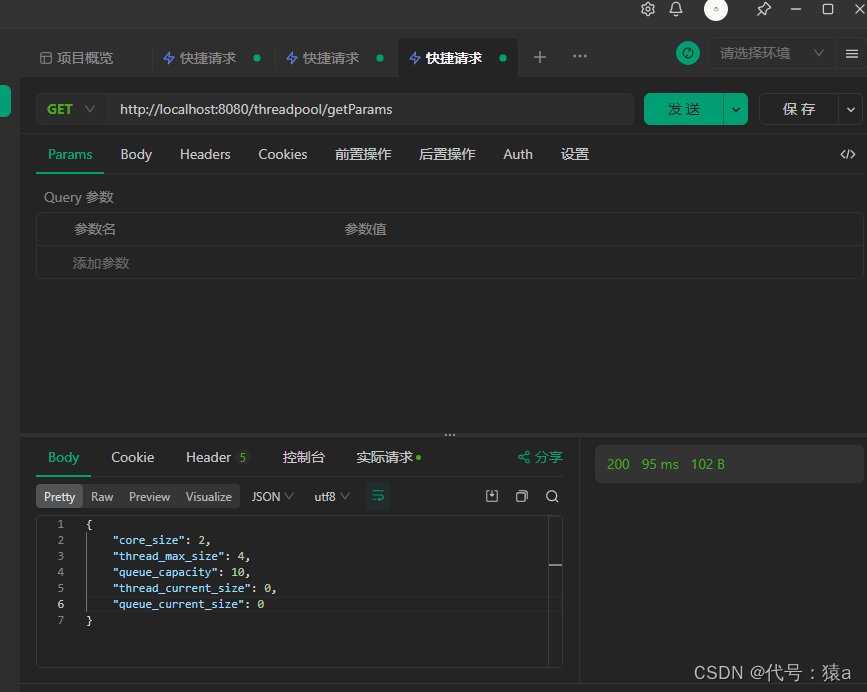
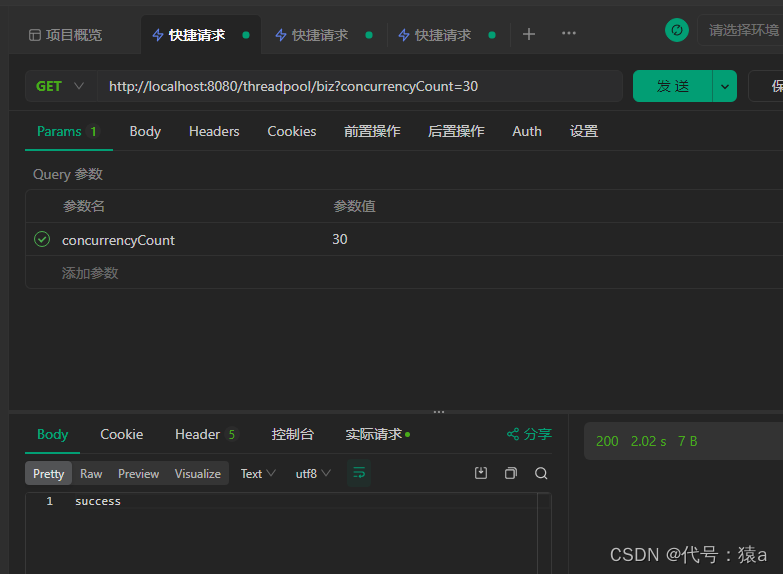
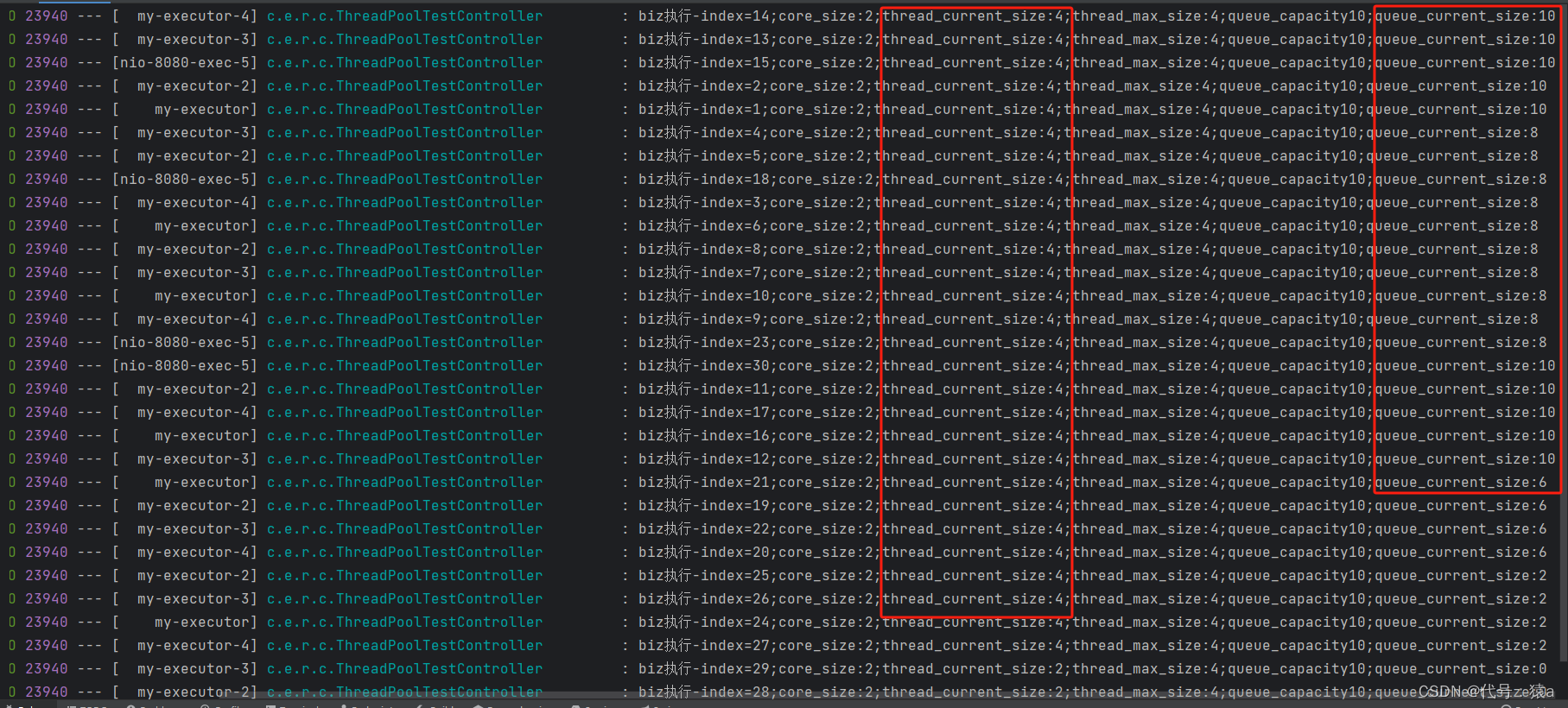
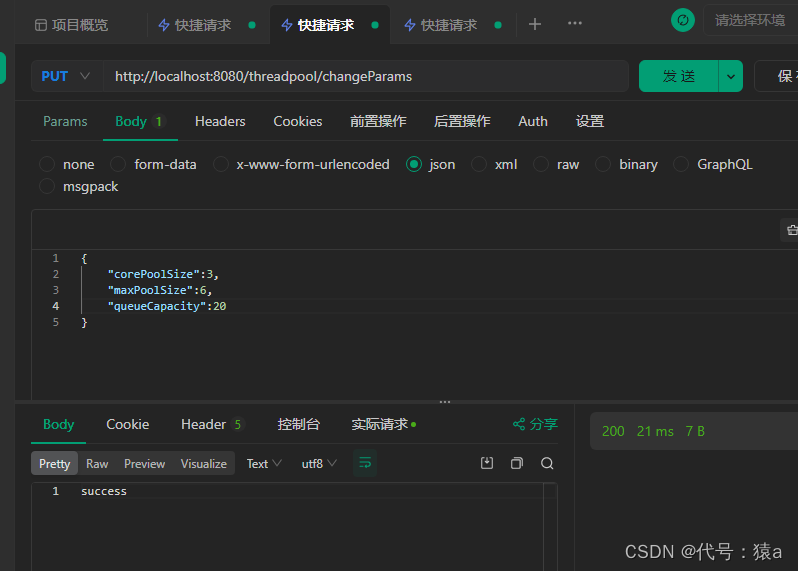
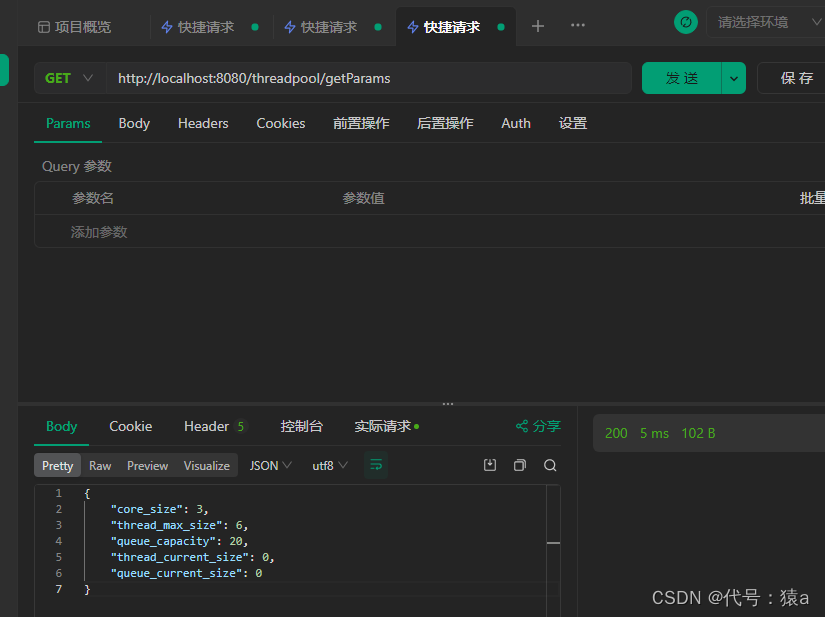
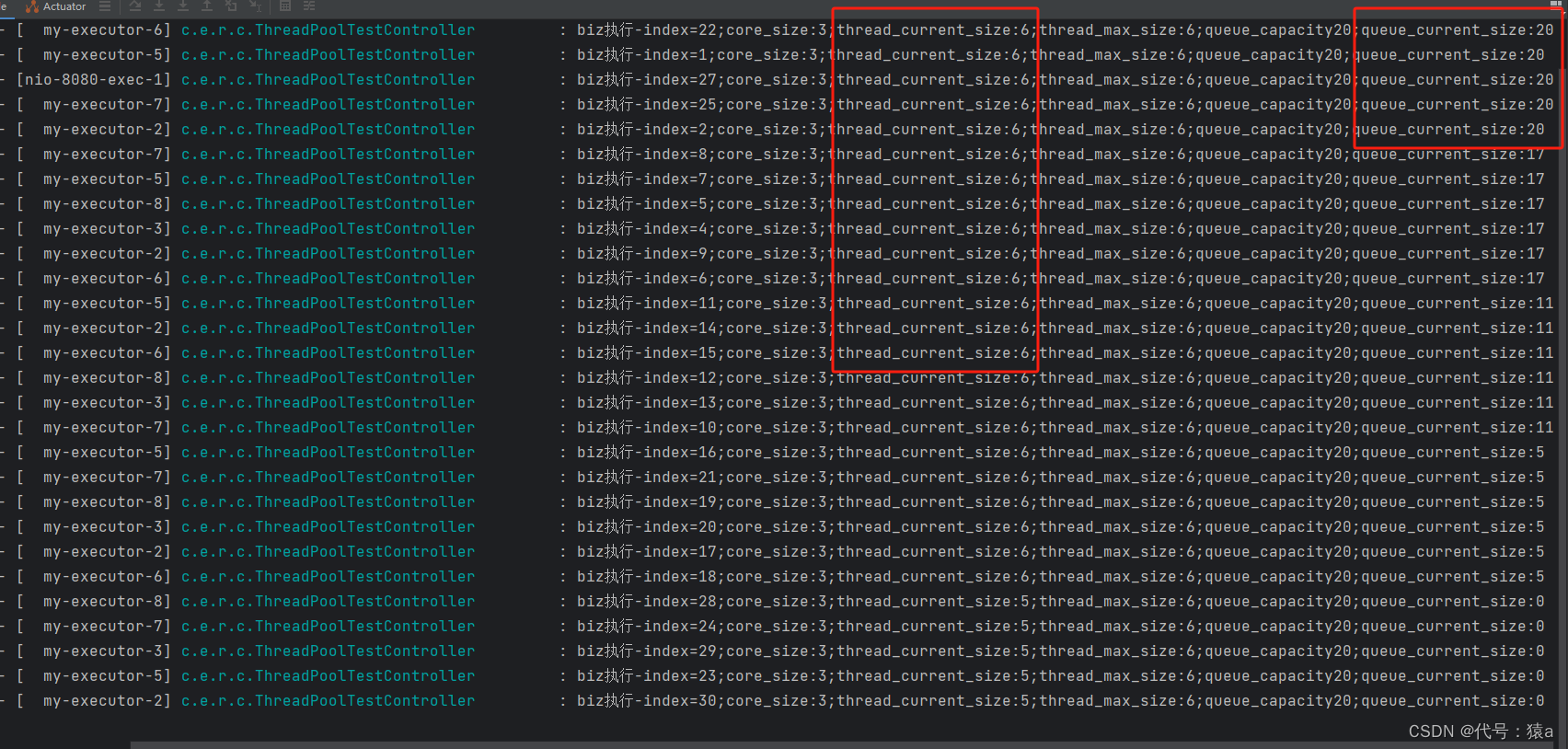














 4057
4057











 被折叠的 条评论
为什么被折叠?
被折叠的 条评论
为什么被折叠?








